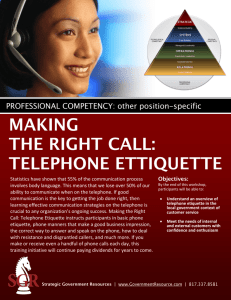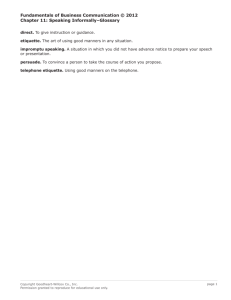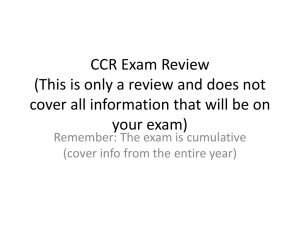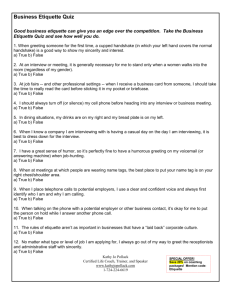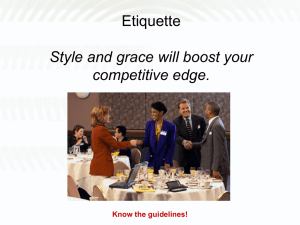PROFESSIONAL ETIQUETTE Shepherd University
advertisement
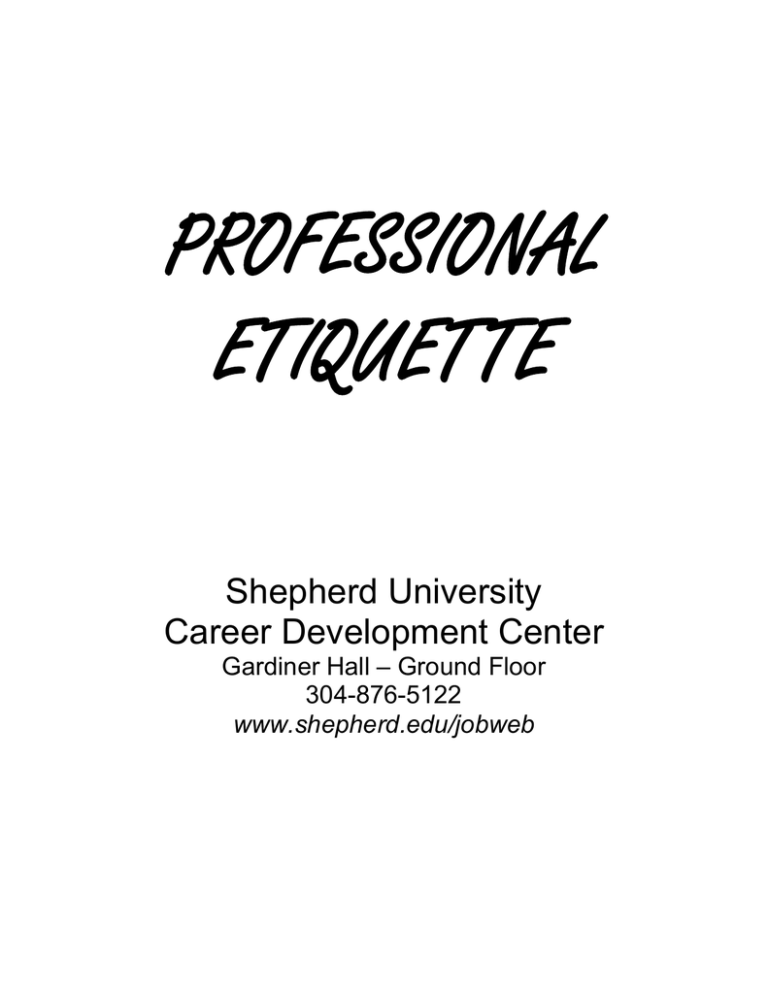
PROFESSIONAL ETIQUETTE Shepherd University Career Development Center Gardiner Hall – Ground Floor 304-876-5122 www.shepherd.edu/jobweb Professional Etiquette Professional etiquette is an unwritten code of conduct regarding the interactions among the members in a business setting. When proper professional etiquette is used, all involved are able to feel more comfortable, and things tend to flow more smoothly. Professional etiquette plays a monumental role in making a lasting positive first impression. In professional situations, displaying proper etiquette can give you a competitive edge over others who may not be using proper etiquette. Likewise, failing to use the correct etiquette may result in being overlooked for employment or losing other valuable opportunities. Professional etiquette can be applied to many areas of an individual’s work life including e-mails, phone calls, and business meetings. Remember that the information contained in this tutorial is based on what is customarily considered proper professional etiquette in the United States. If you are meeting a possible business contact from another culture, or making contacts while travelling abroad, it would be wise to do some research beforehand to find out what is considered proper etiquette in that particular culture. There are many differences in dining style, greetings, perceptions of body language and so forth, worldwide. Being educated on these differences could save you from making a blunder and possibly offending someone or ruining an opportunity for yourself. E-mail Etiquette: Netiquette E-mail is a form of communication that most of us are familiar with, but writing a professional e-mail should be approached much differently than writing an e-mail to a friend or family member. When using e-mail for communication with businesses, potential employers, professors, or people that you have never met before, take these tips into account: Have an e-mail address that is mature and professional-sounding. Potential employers and business contacts will not see you as professional if you have an e-mail address like foxymama@email.com. Be aware of what image your e-mail address conveys to others. Using your first and last name, or initials and last name, etc. are safer bets. Include an appropriate subject line. In the subject line of the e-mail, include a short and to the point description which accurately reflects the subject of the e-mail. Appropriate subject lines help recipients sort and locate specific e-mails in their inboxes; subject lines such as “Hello” do not serve any function. Use your manners! Say please and thank-you in the appropriate places throughout your e-mail. If you don’t, you will come across as disrespectful or rude. Address your recipient appropriately. Business e-mails should contain the recipient’s name. Be sure to use formal titles (Mr., Mrs., Ms., or Dr.) unless the recipient has asked you to use his or her first name. If you are unsure whether a female recipient is married or not, use Ms. Be aware of your tone. You want to sound friendly and approachable in e-mails. Proofread (or have someone else proofread) your business e-mail before sending to make sure that your tone does not come across as disrespectful, aggressive, or demanding. Remove emotion from your e-mail correspondences; never use e-mail to convey anger or annoyance. Do not type in all capital letters, as IT APPEARS AS THOUGH YOU ARE SHOUTING. Using all lowercase letters is also inappropriate. Get to the point. Try to keep your e-mail brief, while still getting your point across. Don’t ramble or repeat information, but also don’t sound too short with the person. Be friendly and clear, but get to the point. When replying to someone else’s e-mail, be sure to provide answers to any inquiries they made to save time and eliminate the need for follow-up e-mails. Avoid emoticons, abbreviations, and fancy formatting. Emoticons (such as smiley faces) do not convey professionalism in an e-mail. Abbreviations that are now common (LOL, TTYL, “U” instead of “you,” etc.) also appear unprofessional, and may not be understood by everyone. Fancy fonts, formats, and layouts can be distracting, so it is best to stick to plain text when composing a professional e-mail. Use proper spelling, grammar and punctuation. Misspelled words and improper use of grammar and punctuation look unprofessional. Proofread (or have someone else proofread) your message before sending; do not rely on spell check alone! Include your full name at the bottom of your e-mail. This will ensure that the recipient knows who has sent them the e-mail. It is also a good idea to have your contact information in your signature, including your postal mailing address and phone number. Reply quickly. When someone sends you an e-mail that requires a response, be sure to reply within 24 hours. If possible, reply as soon as you receive their e-mail. If it will require longer than 24 hours for you to appropriately respond to the e-mail, at least send a reply to the person acknowledging their e-mail and stating that you are working on acquiring necessary information to respond properly. Do not attach large or unnecessary files. Only send attachments that are relevant. Sending a lot of unnecessary or large attachments can slow the recipient’s computer system. If you have a large file that needs to be sent, it may be better to save it on a disk and deliver it. Do not send or forward jokes, chain letters, virus hoaxes, etc. Do not e-mail this type of material to your professional e-mail contacts. It is unprofessional and wastes the time and inbox space of the recipient. Additionally, never send or forward an e-mail that contains potentially offensive, obscene, or defamatory content. Take care with confidential information. Keep in mind that e-mail is not guaranteed to be confidential. If you need to relay sensitive information, it may be best to handle it in person. Sources: Email Replies. Backpack to Briefcase: Steps to a Successful Career. Telephone Etiquette Oftentimes telephone calls precede face-to-face meetings with important professional contacts. When you use proper telephone etiquette you help to ensure that the person you are talking to will want a face-to-face meeting to take place. When placing telephone calls: Keep the time in mind. Be familiar with the hours of operation when trying to reach someone at his or her place of business. Avoid calling right at closing time. If you have been given permission to contact someone at his or her personal telephone number, never call before 8 a.m. or after 9 p.m. Be polite to everyone with whom you speak. Never be rude to administrative secretaries or other support staff who may answer your call. Not only is it unprofessional, but you can be assured that the person that you are trying to reach (professor, potential employer, etc.) will hear about it and this will tarnish his or her opinion of you. Identify yourself. Clearly state your first and last name to the person answering the call, and let them know the reason for your call. Ask if this is a good time to talk. Once you’ve been connected to the person for whom you were calling, ask him or her if this is a good time to talk. This is especially important if you anticipate that your call will last longer than a few minutes. If you know that a particular call will be lengthy, it may be best to schedule a specific time to call. When leaving messages on an answering machine or voicemail, speak in a pleasant tone, be concise and to the point, and be sure to leave your first and last name, the current date and time, your telephone number, and brief explanation of the purpose of your call. Be sure to speak clearly and slowly enough so the listener won’t have to replay the message repeatedly to gather the information. When answering calls: Use a friendly tone and greeting. Smile as you pick up the phone and say, “Hello.” As silly as it may sound, smiling while talking on the phone affects the way you speak, causing you to sound more pleasant. Speak clearly. Avoid eating or chewing gum while on the telephone, as the sounds will be amplified to the person on the other end of the phone. Hold the telephone about two finger widths away from your mouth to ensure that you do not sound muffled. Be mindful of the volume and speed of your speech. Always ask permission before placing someone on speaker phone or on hold. These features should only be used if absolutely necessary. End calls on a pleasant note. Thank the person for calling you and wish them a nice day. Your voicemail or answering machine: Make sure that the recorded message on your voicemail or answering machine is professional sounding in case you should happen to miss a call from a professional or business contact. Make sure the message is polite and states your name. Avoid being funny or clever on your outgoing message, and do not use slang. Return all calls as soon as possible. Cell phones: Do not allow cell phone interruptions. Before meeting with a professional contact, make sure that your cell phone or other electronic device is on silent mode or turned off and put away to avoid interruptions. Also, do not check your missed calls or messages during professional meetings or conversations. You want the person or people with whom you are meeting to see that they have your undivided attention during that time. Remember your surroundings when using cell phones for business or professional calls. Background noise is often picked up by cell phones, so it is a good idea to move to a quiet area before placing or receiving business or professional calls on a cell phone. This is also done out of respect for others who may be nearby, as they likely do not want to be forced to listen to your phone conversation. Also be sure that you are in an area where you get good reception to avoid dropped calls during important conversations. Sources: Backpack to briefcase: Steps to a Successful Career. Virginia Tech Career Services Website. Introductions and First Impressions When meeting professional contacts such as professors, mentors, and potential employers, you only get one chance to make a positive first impression. Some factors in achieving such an impression are appropriate attire and physical appearance, the right verbal and non-verbal communication skills, as well as manners and good business etiquette practices. Physical Appearance: When attending a professional function or meeting with a professional contact: Dress appropriately for the situation. It is better to be slightly overdressed than underdressed. Never wear wrinkled, worn, dirty, stained, or faded clothing. Avoid headwear, shorts, jeans, sweats or athletic clothing, t-shirts, flip-flops, and athletic shoes. Never wear anything that fits too snugly, is low-cut, or otherwise revealing. Shoes should be clean, conservative, free of scuffs, and in good condition. Jewelry should be kept simple and minimal. Any visible piercings other than earrings should be removed. Visible tattoos should be covered. Opinions on body art vary, so it is best not to risk being judged by your tattoos if you have them. Better safe than sorry! Grooming is important. Men should either be clean-shaven or keep facial hair wellgroomed. Avoid outlandish hairstyles. Keep fingernails clean and neatly trimmed or filed. Women should keep make-up simple and fresh-looking. Never groom yourself in public. Use perfume or cologne with caution. Some people are very sensitive to smells, so it is best to limit your use of perfume or cologne, or not wear any at all. Introductions: State your first and last name when introducing yourself. Wear nametags on the right side of your shirt when at a function where nametags are being used. This makes it easy for others to view the nametag as you are shaking hands. Keep your right hand free for shaking hands. During an introduction, stand up if you are not already doing so. Always extend your right hand to shake hands with the other person. When you shake hands with someone, the web of your hand (the area between your thumb and forefinger) should touch theirs. Your grip on their hand should be firm, but not uncomfortable. Handshakes typically should last around 3 seconds and consist of 3 up-and-down shakes. Maintain eye contact with the person to whom you are introducing yourself, or to whom you are being introduced, until the introduction is complete. Remember to smile. Make a closing statement at the conclusion of your conversation such as, “It was a pleasure to meet you.” Never simply walk away after an introduction. Conversing: Use proper grammar and vocabulary. When conversing with others in a professional environment, be sure to speak in a grammatically correct manner, avoid the use of slang words or phrases, and never use foul language. Show interest and respect by using good listening skills. Look at the speaker while he or she is speaking to you, and give that person your full attention. Do not interrupt. Stay focused on what the speaker is saying. When it is your turn to speak, make comments or ask questions about that topic. This will let the other person know that you were in fact actively listening. Avoid topics that could be controversial. A meeting with a professional contact is not the time to debate controversial subjects. Topics that should be avoided in conversations with business contacts include: religion, politics, money, and illegal or questionable activities. Also remember keep romantic details and details involving health conditions within the bounds of good taste. Stick to safe topics when making small talk with professional contacts. Examples of safe topics include: the topic of your meeting or the event you are attending, current events, and books and articles which relate to the industry in which the other person is involved. Don’t forget your body language. When engaged in a conversation with another person, it is important to make sure that your non-verbal communication is just as positive as what you are verbally stating. Good posture, head-nodding, eye contact, and smiling all convey positive messages. Tightly crossed arms, fidgeting, slumping, leaning on objects, and looking away from the other person all indicate something negative (you appear uncomfortable or disinterested.) Sources: Backpack to Briefcase: Steps to a Successful Career. Babson Undergraduate Career Development Website. Southwestern University Career Services Website. Business Meeting Etiquette When you’ve been invited to meet in person with a professional contact it is important to keep a few general rules in mind to show that you respect this person and his or her time. Doing so will help you to make a positive impression, and will make the encounter easier for all parties involved. Confirm your attendance as soon as possible. If for some reason you find that you will no longer be able to attend at the previously agreed-upon time, inform the other person(s) involved immediately and offer a sincere apology for any inconvenience. Arrive on time. Nothing makes a bad first impression faster than being late. In fact, it is a good idea to arrive a few minutes early to allow for any last minute preparations. Be prepared. Know what you are there to discuss, and have any questions or ideas that you may have thought of jotted down so you will not forget them. Bring along a pen and notepad to make notes during the meeting when necessary. Be sure to bring any additional materials that you are expected to have. Knock before entering if you are meeting someone in his or her office. In this environment, do not sit before being invited to do so. Have cell phone turned off or set to silent mode. Do this before entering the meeting. Do not check your phone or messages until leaving the meeting. Actively participate in the meeting by asking questions and making appropriate comments. However, you should avoid interrupting others or being critical or negative. Also, try to stay on topic. Thank others for the opportunity to meet with them. Source Backpack to Briefcase: Steps to a Successful Career. Dining Etiquette Basics There may be times when you will meet with a business contact over a meal or attend a professional function where food is involved. It is possible that you may even attend a job interview held at a restaurant. For these reasons, it is important to know proper dining etiquette so that you may make a good impression. Be polite to all restaurant staff that you encounter. The people you are dining with WILL notice your manners and the way that you treat others. Cell phones should turned off or on silent mode. They should not be seen or heard during the meal. Being seated: Wait to be seated by restaurant staff or your host. When you sit down, place purses, bags, or briefcases out of the way on the floor beside you or under your seat. Never place these items on the table. Ordering: Do not pick up your menu until after your host has done so. Allow your host to order first. When choosing your meal, consider selections that will not be messy or awkward to eat. It is best to stick to something that you are familiar with, so you will know the proper way to eat the food. If your host is paying for the meal, avoid choosing the priciest selections on the menu. It is wise to avoid alcoholic beverages. Your napkin: Once you’ve been seated at the table, unfold your napkin and place it in your lap. Never shake out your napkin, crumple it, or stuff it into your clothing. If you need to use it during the meal, just bring a corner of it up from your lap and gently blot your mouth with it and return it to your lap. If you need to leave the table during the meal, place the napkin in your chair until you return; do not put it back on the table. If you drop your napkin onto the floor, do not retrieve it. Instead politely ask your server for a new one. When everyone is finished their meal and leaving the table, you may return your napkin to the table (to the left of the plate, if the plate is still there). Do not rest your elbows or arms on the table. Also try to avoid fidgeting in your seat, and try to maintain good posture. Feet should be flat on the floor in front of you. Your silverware: In a formal place setting, there may be an assortment of utensils on either side of your plate. Forks will be to the left, while spoons and knife will be to the right, and there may even be utensils for dessert on the table above your plate. Each utensil serves a specific purpose (salad fork, soup spoon, tea spoon, etc.) and the ones placed farthest away from your plate on either side are the ones that will be used earliest in the meal as each course is delivered. You work your way in to the utensils closer to your plate as the meal progresses and courses are served. If you are confused about which utensil you should be using, follow your host’s lead. Never place a used utensil on the table or tablecloth; they should rest on the edges of your plate, with knife at the top edge and forks and spoons on the side edges. If you drop a utensil on the floor, do not retrieve it; politely ask your server for a new one. When you are finished eating, you should place your fork and knife diagonally across your plate with the sharp edge of the knife facing away from you (in the 4 o’clock to 11 o’clock position) to indicate to your server that you are finished. Things to remember while eating: - Allow your host to begin eating or drinking before you do so. - Bring your food toward your mouth rather than leaning in toward the food. - Close your mouth while chewing and never speak with food in your mouth. - Never blow on your food to cool it. - Do not eat with your fingers unless the food is a traditional “finger food” such as a sandwich, berries, etc. - Try to eat at the same pace as the others at your table. - Never “double dip” into shared appetizers or dishes. - Do not scrape your plate with silverware. Eating Soup: Use your spoon to lift soup by dipping in the direction opposite yourself (rather than shoveling towards yourself) and gently move the bottom of the spoon against the inner rim of the bowl to remove any drips before bringing the spoon towards your mouth to sip. You may tip your bowl slightly away from you when trying to get the last bit of soup onto your spoon. Never pick the bowl up from the table or drink from it. Excuse yourself to the restroom should you have to remove food from your teeth, take medication, or groom yourself in any way during the meal. These things should never be done at the table. The Bill: Assuming that you are the invited guest who is being treated to a meal, if the server accidentally places the bill in front of you at the end of the meal, do not make a big deal out of it. Wait for your host to notice the mistake and take the bill. If he or she does not take the bill from you, politely offer to split the expense. Always be capable of payment, even if you are of the understanding that the other person is treating you. Always thank your host for the meal and for taking time to meet with you!! Source Backpack to Briefcase: Steps to a Successful Career. Business Etiquette & Protocol.
